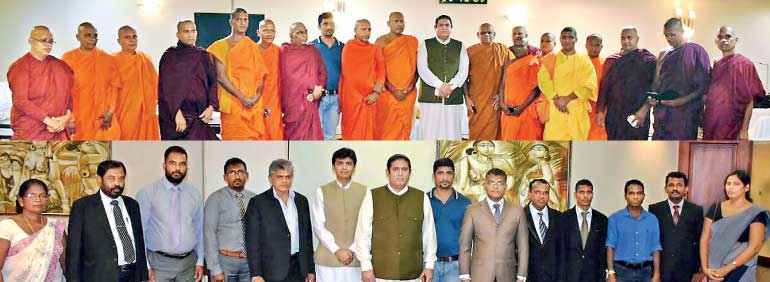Monday Apr 21, 2025
Monday Apr 21, 2025
Monday, 22 May 2017 01:24 - - {{hitsCtrl.values.hits}}
On the invitation of the Government of Pakistan, a 34-member delegation, led by Kanumuldeniye Chandavimala Mahanayaka Thero, comprising senior monks, religious scholars, Government Officials and pilgrims left for Pakistan today to attend the Vesak Festival at Taxila hosted by the Pakistani Government for the second consecutive time from 21-24 May.
Acting High Commissioner of Pakistan Dr. Sarfraz Ahmed Khan Sipra and other officials of the High Commission of Pakistan were there to see off the delegation at the Bandaranaike International Airport.
Despite being a predominantly Muslim country, Pakistan is celebrating the Vesak Festival and many countries are being invited for the celebrations.

On the sidelines of the Vesak Festival, the delegation will be visiting different sites of Buddhist spiritual and religious significance in Taxila like Dharmarajika Stupa, Sirkap and Taxila Museum besides the visit of Takht-i-Bahi.
Pakistan has been a cradle of Buddhist and Gandhara civilisation for well over 22 centuries. Buddhism left a monumental and rich legacy of art and architecture in Pakistan. Despite the vagaries of centuries, the Gandhara region preserved a lot of the heritage in arts and craft. The Gandhara civilisation flourished in the north-western region of Pakistan from the 6th Century BC to the 5th Century AD.
The territory of Gandhara civilisation and its heritage is a triangular piece of land about 100 kilometres, east to west and 70 kilometres north to south, on the west side of the Indus river, surrounded by mountains in present day Pakistan.
The Gandhara School of Art is credited with being the first creators of Buddha in human form carved in stone, stucco, terracotta and bronze. These were mostly enshrined in monasteries and stupas throughout the Gandhara region. A major portion of this invaluable heritage has been preserved in the museums and the sacred sites at their original locations.